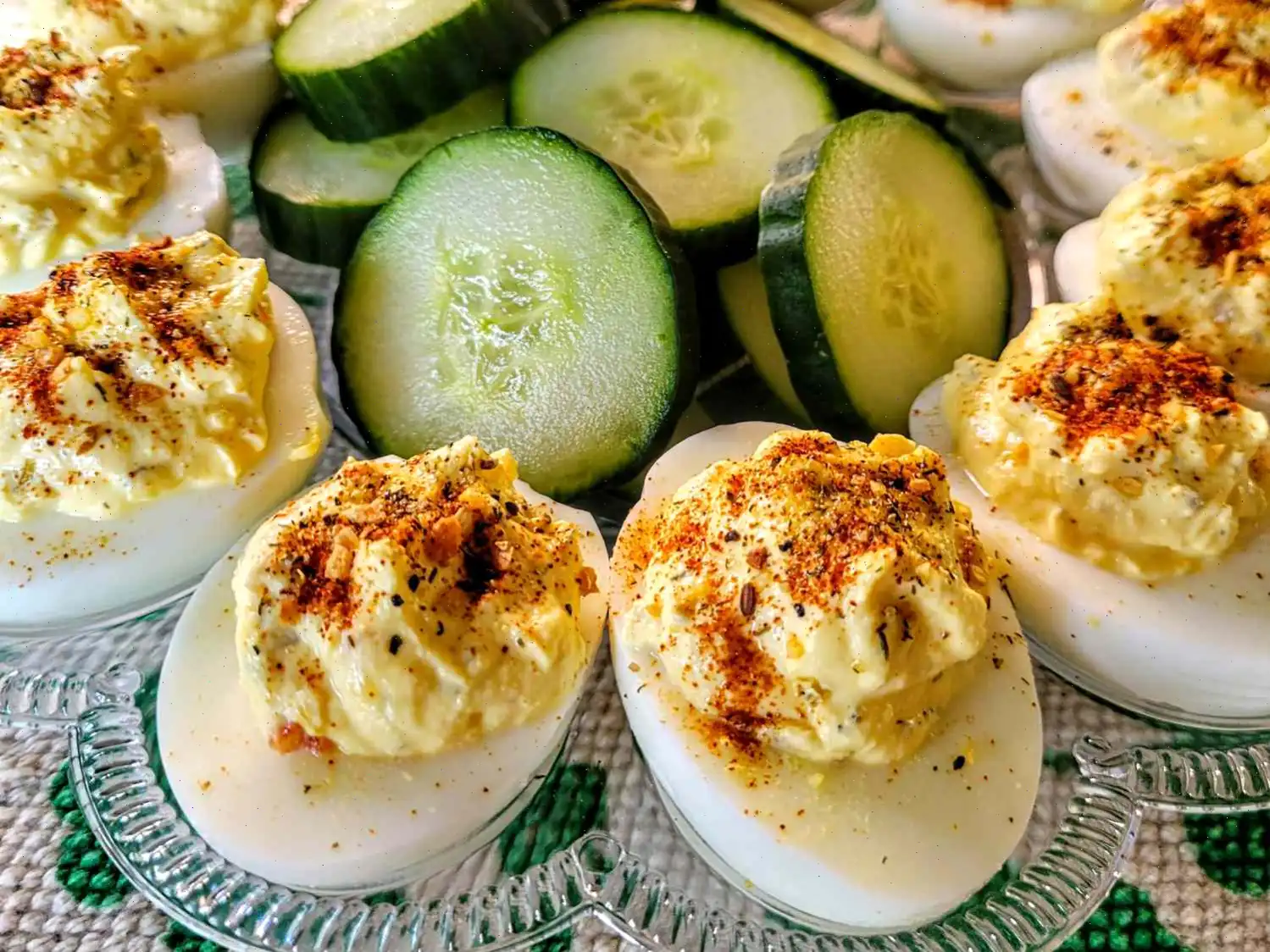
Mediterranean Deviled Eggs Recipe
Ingredients
This recipe yields 12 servings:
- 6 large hard boiled eggs, peeled
- 1/4 cup Greek yogurt
- 1 teaspoon white vinegar
- 1 tablespoon chopped fresh dill
- 2 tablespoons feta cheese
- 1 tablespoon finely chopped olives
- 1 teaspoon brine from olive jar
- 1/2 teaspoon garlic powder
- 1 pinch smoked paprika, or to taste (optional)
Directions
- Slice the eggs in half lengthwise and carefully remove the yolks. Set the egg whites aside.
- In a small bowl, mash the yolks with a fork until smooth.
- Add the Greek yogurt, vinegar, dill, feta cheese, chopped olives, olive brine, and garlic powder to the mashed yolks. Mix well until all ingredients are fully combined.
- Spoon or pipe the yolk mixture into the hollowed-out egg whites.
- Sprinkle with smoked paprika, if desired, to add a smoky flavor and a touch of color.
- Refrigerate the filled eggs until ready to serve. Enjoy!
Nutrition Facts (per serving)
| Calories | 47 |
|---|---|
| Total Fat | 3g |
| Saturated Fat | 1g |
| Cholesterol | 95mg |
| Sodium | 56mg |
| Total Carbohydrate | 1g |
| Dietary Fiber | 0g |
| Total Sugars | 1g |
| Protein | 4g |
| Calcium | 26mg |
| Iron | 0mg |
| Potassium | 41mg |


Deviled eggs, a beloved appetizer, have been around for centuries. This version, the Mediterranean Deviled Eggs, takes a classic dish and infuses it with the bold flavors of the Mediterranean, including Greek yogurt, feta cheese, olives, and dill. These ingredients bring a refreshing twist to the creamy richness of traditional deviled eggs.
Origin of Mediterranean Deviled Eggs
The exact origin of deviled eggs is somewhat unclear, but the concept dates back to ancient Rome. The Romans are credited with creating a recipe similar to deviled eggs, where boiled eggs were seasoned with various spices and served as appetizers. Over the centuries, the dish evolved, and it gained popularity in the United States in the mid-19th century. The Mediterranean version of deviled eggs draws inspiration from Greek cuisine, known for its use of yogurt, olives, and feta, which lend a tangy and savory twist to the traditional recipe.
Regional Variations
The Mediterranean region is home to a wide variety of ingredients and culinary traditions, and this is reflected in the Mediterranean Deviled Eggs. In Greece, for example, the use of Greek yogurt is common, offering a lighter, tangier alternative to mayonnaise, which is typically used in American deviled eggs. The addition of feta cheese and olives adds depth and complexity to the dish, making it distinctly Mediterranean. While Greek yogurt and feta are widely used throughout the region, other countries like Italy or Spain might opt for different herbs or types of olives, such as Kalamata, to impart their unique regional flavors.
How It Differs from Traditional Deviled Eggs
Traditional deviled eggs typically consist of hard-boiled egg yolks mixed with mayonnaise, mustard, and seasonings like paprika. The Mediterranean version, however, swaps mayonnaise for Greek yogurt, resulting in a tangier and lighter filling. Additionally, the inclusion of feta cheese and finely chopped olives offers a savory and slightly salty punch, contrasting with the creaminess of the yogurt. The smoked paprika used as a garnish further enhances the flavors, adding a subtle smokiness that is characteristic of Mediterranean cuisine.
Where to Serve Mediterranean Deviled Eggs
Mediterranean Deviled Eggs are versatile and can be served at a variety of occasions. They are perfect as an appetizer for casual gatherings, barbecues, or potlucks. Due to their light yet flavorful nature, they are also great as a snack or side dish at Mediterranean-themed dinners or parties. Their visually appealing presentation, with a sprinkle of smoked paprika and fresh dill, also makes them a popular choice for holiday gatherings or special events, adding an exotic flair to the table.
Interesting Facts About Mediterranean Deviled Eggs
- The concept of "deviled" eggs comes from the term "deviled" meaning spiced or seasoned, referring to the dish's flavor profile.
- Greek yogurt is a key ingredient in Mediterranean cooking, known for its health benefits, such as being rich in protein and probiotics.
- The combination of feta and olives in Mediterranean Deviled Eggs represents two staples of Mediterranean cuisine, often used in salads, dips, and other appetizers.
- In Greece, deviled eggs are sometimes enjoyed as part of festive meals or as a light starter during family gatherings.
- The inclusion of olive brine not only adds flavor but also a touch of Mediterranean authenticity, reminiscent of the region's famous olives.
Conclusion
Mediterranean Deviled Eggs offer a delightful variation of the classic deviled egg, bringing in vibrant, savory flavors that are distinctly Mediterranean. With its creamy Greek yogurt filling, tangy feta, and briny olives, this version of deviled eggs is sure to stand out at your next gathering, whether its a casual picnic or a formal celebration. Its a simple yet sophisticated dish that blends tradition with the bold tastes of the Mediterranean, making it a crowd-pleaser for any occasion.
FAQ about Mediterranean Deviled Eggs Recipe
Comments
David Williams
10/18/2024 07:59:01 PM
We absolutely adore deviled eggs, so I was certain we'd enjoy this unique version, and we absolutely did! I found myself adding a bit more yogurt than the recipe originally stated, and I decided to go with green olives since that's what I had available, even though the recipe didn't specify. The taste was fantastic, and the entire family couldn't get enough of them!
Debra Anderson
11/11/2022 06:22:14 AM
The recipe didn't specify which type of olives to use, so I opted for Kalamata to complement the Mediterranean theme. I sprinkled some salt and the addition of olive brine and vinegar brought a delightful tang to the dish. Deviled eggs are always a popular appetizer that vanishes in no time.
Jack Torres
12/31/2024 07:58:49 PM
Deviled eggs are a hit with my family every time. While we enjoyed them, we found that using yogurt instead of mayonnaise resulted in a slightly less smooth texture. The recipe didn't specify which olives to use, so I went with green olives. This variation with green olives adds a tangy twist to the classic recipe, perfect for those looking to try something new.
Joshua Davis
08/24/2024 12:26:37 AM
Such an amazing dish!
Aaron Wright
10/26/2022 01:09:11 AM
I made these and was extremely happy with how delicious they turned out. My family loved them too, and I believe the recipe is worth sharing with my sisters. I will definitely be making these again!









